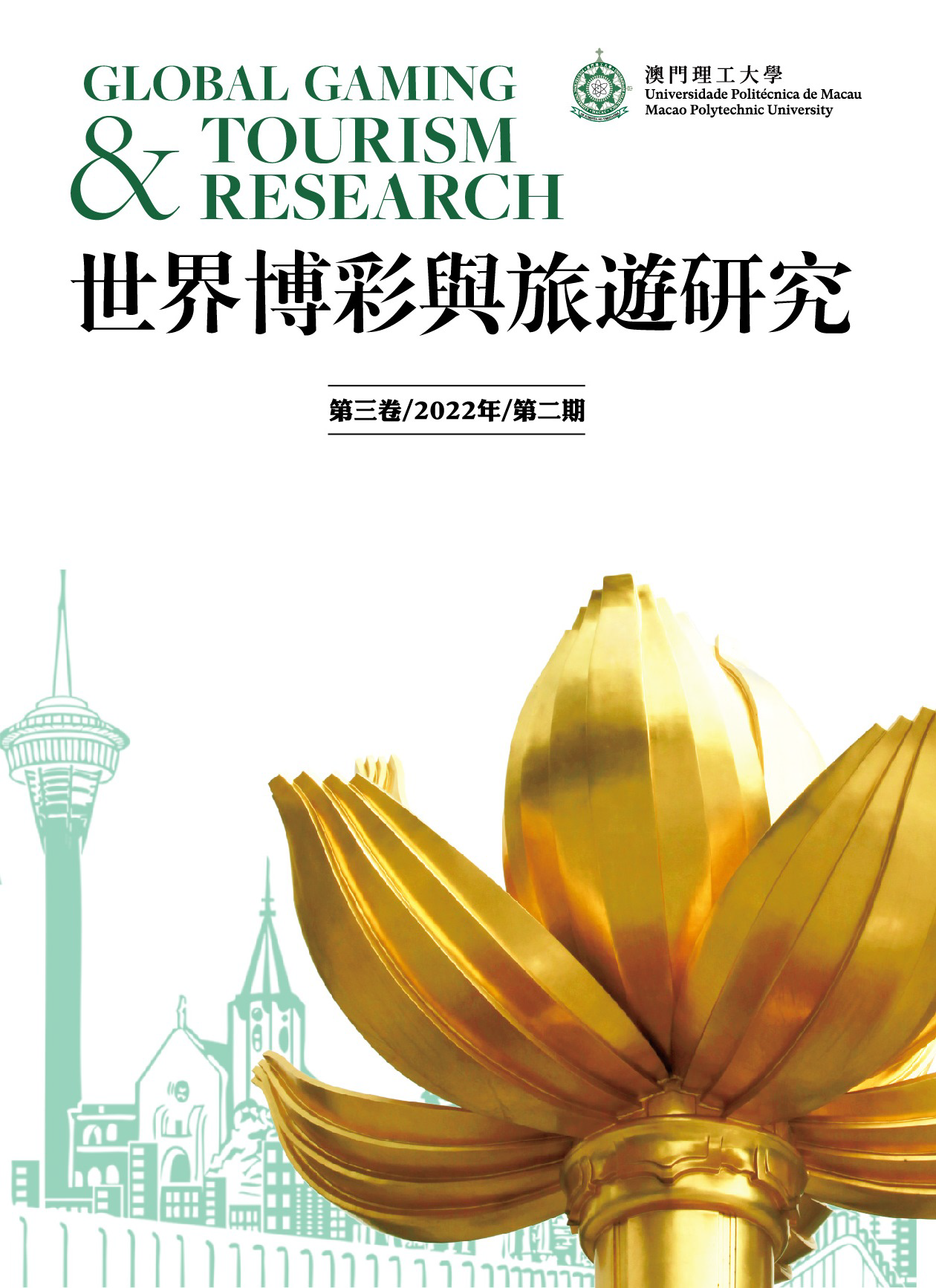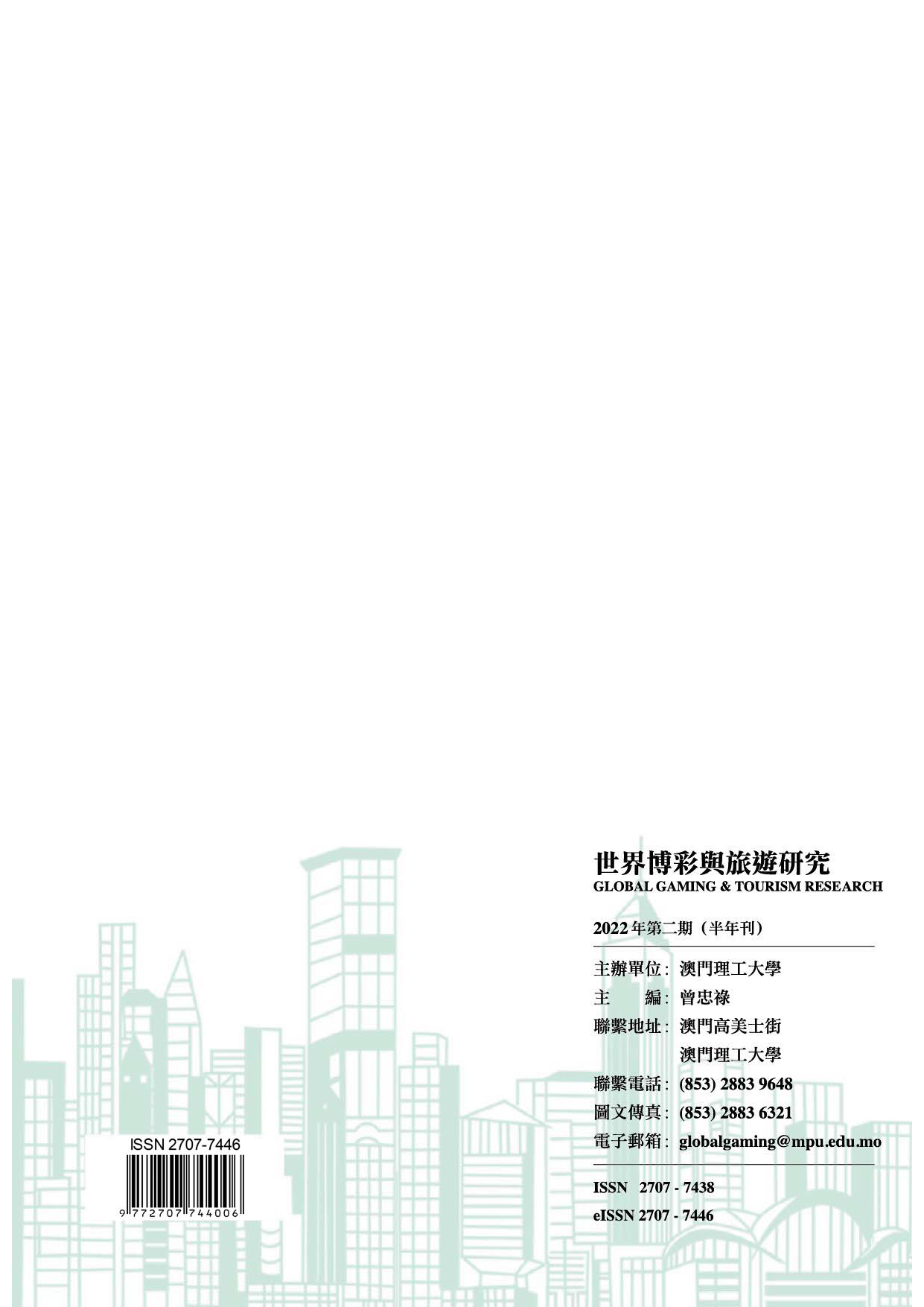Estudos na Área do Jogo e do Turismo Mundial


|
ISSN: |
ISSN 2707-7438 eISSN 2707-7446 |
|---|---|
|
Period: |
Semi-annually |
|
Introduction: |
“Global Gaming & Tourism Research” aims to promote the sustainable development of the gaming and tourism industry. In addition to providing support for science-based decision-making across the public and gaming sectors, this academic journal seeks to serve as an exchange platform for gaming and tourism research work. “Global Gaming & Tourism Research” covers such key areas as the development trend of the Macao and global gaming industries, evolution and trend of consumer preference among gaming tourists, responsible gaming theory and practice, tourist behaviour theory and case studies, and tourist destination management theory and practice, etc. Contributions by experts, scholars and industry practitioners are welcome. |
|
|
|
Macao's Gaming Industry and Moderate Economic Diversification: A New Structural Economics Perspective
Macao’s gaming industry has contributed more than half of its overall economy for many years. However, since the outbreak of COVID-19 in late 2019, the industry has been hit hard with the tightening of epidemic prevention measures, the sharp decline in tourist arrivals, and the unexpected persistence of the epidemic, resulting in a lack of economic growth and highlighting the problem of structural homogeneity. Based on the quarterly data of the industry and Macao’s GDP from 2013 to 2022 as a sample, this study employs the VAR model and Granger causality test to analyze the impact of the industry on Macao’s economy during the pandemic. The results indicate that the gaming industry did not have a significant contribution to the overall economy during the sample period, its impact on Macao’s employment was relatively small, and the industry was more vulnerable to the pandemic impact. Drawing on the paradigm of new structural economics, this study analyzes the four new industries corresponding to Macao’s diversification in the Guangdong-Macao In-Depth Cooperation Zone in Hengqin, to develop a moderately diversified industrial structure by under the factor endowment structure of Macao and Henqin.
|
Liu Chengkun, Li Xinran |
|
Chinese Investment in the Gambling Industry in Africa
Based on the fieldwork in a number of countries in Africa (like Tanzania, Zambia, Angola, and Kenya) and interviews with such relevant stakeholders as Chinese investors, gambling industry managers and African government officials, this article analyzes the investment and operation of Chinese enterprises in the African gambling industry, especially offline casinos, online gaming and lottery. It examines the role of the Chinese capital in the development of the African gambling industry, and the role played by African governments in the development process. This study points out that the Chinese capital involved in the gambling industry is subject to dual regulations in both Africa and China, and the related regulatory policies are quite uncertain. All these inevitably pose more challenge to the adaptability (especially to the changing laws and regulatory policies), operational capacity, risk resistance, professional capability and corporate social responsibility of gambling operators.
|
Li Hangwei |
|
The Birth of the First Generation Casino Hotels in Las Vegas
In the old days Las Vegas casinos were clustered in downtown area. Simple and crude, they were little more than old lodgings with some gambling devices. The birth of El Rancho Vegas in 1941 is a game changer to Las Vegas casino industry. It is the very first hotel built on what is known today Las Vegas Boulevard. The hotel was masterplanned to integrate gambling, room, food & beverage, entertainment and retail under one roof. Along with this innovative approach was the business model it created based on the unique feature of a casino hotel. In El Rancho Vegas the casino was the pivotal part of the entire operation and gamblers were its prime target market. All non-gaming departments were playing supporting roles by attracting people into the door with their low-priced products. Casino was essentially the exclusive source of profit, leaving other departments little chance to cultivate their own customer bases. This model has been proved highly successful given the business environment at that time. El Rancho Vegas heralded the history of the first generation casino hotel prompting a good number of new properties on the heel of it. Of those newly emerged Flamingo Hotel & Casino stood out in terms of both scale and quality. All new comers were loyal followers of El Rancho’s business model. Together they set up the first monument to the future glory of Las Vegas Boulevard, The Strip.
|
Gordon Yeh |
|
On the Social Gaming Activities in the Dream of the Red Chamber
The major social gaming activities in the Dream of the Red Chamber included “play cards”, “roll the dice”, “play Go”, “play Chinese drinking games”,“versify” and the like. These activities are conducive to breaking down the hierarchical boundaries within the Jia’[KG-*3]s Mansion, and increasing communication and understanding among family members. They are also beneficial to strengthen communication with people outside the Mansion and broaden the vision of the people in the Mansion. The social gaming activities in the “Dream of the Red Chamber” vividly illustrate the daily life of a large aristocratic family in the feudal society, which are of great value and significance to our understanding of social gaming in ancient China.
|
Liu Xiangyu, Liu Chenxi |
|
|
|
Study on the Spatio-Temporal Evolution Characteristics of the Centrality of Tourism Flow Network Around Macao
The tourism markets of the neighbouring countries (regions) are crucial to the development of Macao’s tourism industry. This study analyzes the spatio-temporal evolution characteristics of tourism flows in Macao and its neighbouring countries (regions) from 2016 to 2019 through five indicators including influence, centripetal force, radiation force, binding force and affinity. The results show that Macao’s eigenvector centrality decreases annually, indicating that its tourism exchange with other countries (regions) in the network has been decreasing annually, and currently has less influence in the network. Although Macao’s authority index rebounded in 2019, it shows a decline as a whole suggesting that Macao’s tourism attraction to other countries (regions) in the network has diminished. Macao’s hub index slightly declined in 2019 and may probably be overtaken by other countries, illustrating a downward trend despite its strong ability to become a transit point for neighbouring destinations. The affinity indicator continues to decline, indicating that Macao’s indirect ties with other countries (regions) are less frequent and its proximity to high quality destination has increased. The radiance indicator, although relatively stable, remains at the bottom of the network. This indicates that Macao’s links with other destinations are weak as a source. This study identifies the characteristics of the spatial and temporal evolution of online tourism flows of Macao and neighbouring countries (regions), and makes recommendations for Macao to develop tourism markets in neighbouring countries (regions).
|
Zhou Wenjing, Yin Ping, Meng Qingrui |
|
New Developments in the Study of Religious Tourism in China and Its Implications for Macao Tourism
This study examines the beginning, new developments and trends in the study of religious tourism from a comparative perspective between the East and West. In this interdisciplinary dialogue, religious tourism research links the sacred and the secular, the material and the spiritual, the global and the local, as well as apply new methods and research new issues, thereby breaking disciplinary bottlenecks and transcending boundaries in a new social context. The introduction of relatively mature theories and research methods from the West has played an important role in promoting the rapid development of religious tourism research in China. At the same time, domestic research attempts to integrate social contexts in China have also provided inspiration for foreign research. Despite the potential trend of complementary strengths and dialogue between the East and the West, the research on the domestic concept is still relatively weak, and has yet to contribute the Chinese experience and theory to the development of world religious tourism research. Finally, the study intends to provide practical references for the development of religious tourism in Macao from such aspects as plurality, mobility, embodiment, materiality and emotion.
|
LI Yu |
|
A Review of Tourism Destination Governance and Prospects for Cross-regional Governance
Destination governance is closely related to destination management. Although the study of tourism destination governance has a short history, it has attracted much attention from scholars in less than 20 years. Based on a review of the relevant literature, this paper investigates the concept, models and evaluation of tourism destination governance. While existing studies have not reached a unified conclusion on destination governance, particularly cross-regional governance, there is a growing body of research suggesting that effective destination management needs destination governance. In particular, cross-regional governance has research value and significance in the development of cultural tourism in the Guangdong-Hong Kong-Macao Greater Bay Area, and the tourism development in the Guangdong-Macao In-Depth Cooperation Zone in Hengqin.
|
Zhang Yihang |
|
Research on the Therapeutic Experience of Tourists in the Old Town of Lijiang
Therapeutic landscape theory suggests that environment and experience are key to understanding the “therapeutic” nature of a landscape, thereby providing an important research idea for analyzing the interaction between tourism and health. Following this, this study attempts to empirically investigate the interaction between environment, therapeutic landscape, and tourist experience with a group of travellers in the Old Town of Lijiang as the research object. Through interviews and textual analysis, the study has reached such conclusions: (1) the natural, social and symbolic environment in the Old Town of Lijiang has formed a contrasting environment with complementary benefits to the daily life of travellers by providing objective and external conditions for their therapeutic experience; (2) physical, emotional and social experiences not only are the ways in which travellers are linked to the therapeutic environment, but also are the concrete manifestation, formation process and result presentation of the therapeutic experience of the Old Town. The study attempts to break through the individual centredness or anthropocentrism of “causality” or “explanatory mechanism” in the interaction between tourism and health, and move towards a more systematic consideration of the relationship between tourism, health promotion and increased social well-being from both ends of the “people-place” continuum, thus offering practical guidance for tourism destinations to effectively respond to the growing health needs.
|
Huang Qingyan, Bai Kai |
|
A Study on the Design Perspectives of the Hotel Fitness Needs for Seniors' Tourism Groups in China
This paper focuses on how hotel fitness can meet the needs of China’s elderly travellers, a major opportunity for China’s tourism industry to develop a silver-haired economy. Based on the Chinese elderly tourism group as the research object, this paper reviews the literature, collects data through questionnaire survey and in-depth interviews, analyzes the fitness behaviour of this group in tourism hotels, and identifies the needs for psychological relaxation, physical safety and social convenience in the enjoyment of such fitness facilities. To address these needs, this study suggests the generalization of fitness environment and equipment, smart digitalization of fitness equipment with urban features, and the localization of fitness equipment. This study also explores the generalization of fitness environment, smart digitization of fitness equipment and the integration of fitness equipment, with a view to providing useful reference for the setting of the hotel fitness facilities and promoting the silver economy.
|
Xu Guiping, Wu Yue |



